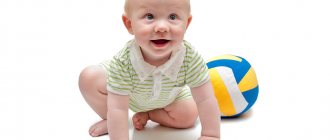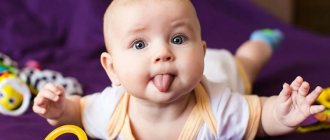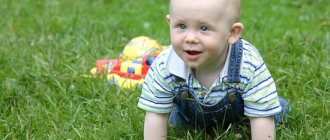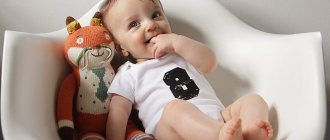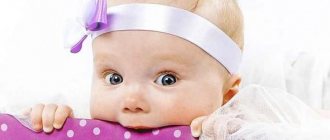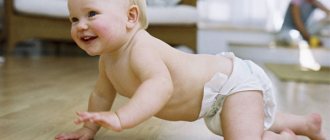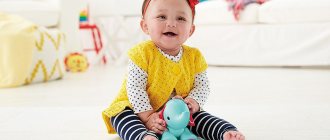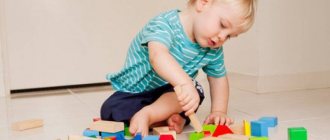At about one year the child begins to walk. But it takes about six months to master confident independent walking.
At first, maintaining balance is not so easy, and the baby often loses it. Don't be alarmed: falls are inevitable.
At the same time, kids, unlike adults, are relaxed, so your child is not in danger of serious injury, if, of course, you take the necessary precautions, i.e. try not to leave the baby alone in the bathroom, remove obstacles such as a coffee table from his path , stools or scattered toys and, of course, try to always be on the alert.
Insuring your child is a wise decision. You shouldn’t surround him only with prohibitions and panic in vain.
Features of age
A one and a half year old baby is already showing some interest - listening to fairy tales, songs, and reacting to a familiar melody. Parents are advised to contact their child more often; over time, he will try to repeat after adults, which promotes speech development.
At one and a half years old, the child begins to eat on his own, confidently holds a fork and spoon, tries to bite off and chew solid food. The baby drinks from a mug without the help of his parents, although not always successfully. In everyday life, the child is also active - putting away toys, “reading” books, trying to brush his teeth, and get dressed. He washes himself with pleasure, and playing with a stream of water brings more joy than washing himself.
Baby care
Due to the fact that the baby is already familiar with the potty, there is no need for frequent washing. However, daily hygiene procedures remain the same: brushing teeth, bathing and washing. Walks in the fresh air are required - at least 2 hours.
Your baby may begin to show signs of cleanliness.
Sometimes at this stage of development, the baby himself shows the first signs of cleanliness: he wipes his dirty hands or asks to wash them, holding them out in front.
Physical development of a child at 1 year and 6 months
At 1.5 years old, most children already begin to move confidently without the help of their parents. Kids learn to squat, climb stairs, and independently bend over to pick up toys or objects of interest. You shouldn't expect too much - he still holds himself unsteadily, falls, and is rather clumsy. The danger that awaits the child is that, thanks to a poorly developed sense of self-preservation, it is easy to get injured. It is not recommended to leave it indoors even for a short time; safe items can cause harm to health.
Physical skills develop at a rapid pace at the age of one and a half years. The baby moves actively, loves to swing, go down slides, and frolic with his peers. Parents constantly need to be on alert - curiosity and energy can play a cruel joke.
Baby's sleep
By the age of 1.5 years, the child sleeps only once during the day. The second nap can be short - only 40 minutes. Night sleep takes about 12 hours. This is quite enough to charge the baby with energy to explore the world around him during the day. The day should be organized so that the main physical activity occurs in the first half of the day.
The evening should be spent more calmly, folding cubes and looking at pictures. Excessive evening activity can cause a child to scream at night and be capricious before falling asleep.
Games for a one and a half year old baby
How to develop a child during this period? How can you interest this fidget? For high-quality sensory development of a baby at 1 year and 6 months, it is necessary to play different types of games with the baby:
- Construction - using a constructor or cubes to make various devices for dolls (cribs, houses).
- Thematic fun - bathing, feeding, putting dolls or bears to bed, flying with an airplane, jumping with a bunny.
- Didactic - for these games we use nesting dolls and pyramids with rings.
Parents' flight of fancy should not be limited. After all, the main thing is that the baby has fun. You can play with the cereal, pouring it from one container to another. This develops fine motor skills of the hands.
Alarm bells for parents:
- A child at 1 year and 6 months does not speak a single coherent word.
- By the age of 1.5 years the baby does not walk.
- The elementary game of “okay” is difficult for him.
- The baby expresses all his needs only by screaming and crying.
- He walks only on his toes.
- Deliberately hits his head on the sides of the crib or other objects.
Child's emotional development:
- is surprised by new objects and frightened by unexpected actions
- easily switches from one subject to another
- rejoices and laughs when he succeeds at something
- expresses his disagreement by shouting
- perceives familiar people joyfully, unfamiliar people with caution
- “infected” with emotions - may cry if someone around him is crying and vice versa
Neuropsychic development of a child at one and a half years old
It is not difficult to determine whether neuropsychic development has deviated from the norm; it is important to carefully observe the character and behavior for several days. Baby skills that correspond to the norm:
- shows interest in examining the room, tries to look into all the nooks and crannies;
- loves to play hide and seek with adults;
- knows how to sort toys by shape, color, size;
- stacks pyramids;
- knows how to distinguish body parts, points with a finger or touches with a hand when he hears a name from his parents;
- learns to find familiar pictures in books; at the request of his parents, he shows a dog, a cat, a bunny.
You need to be wary if a child has difficulty walking, does not respond to the speech of adults, or does not even notice the absence of one of the parents. In such cases, it is recommended to go to the pediatrician and explain the behavior of your son or daughter.
We are growing! All about the development of a child from 1 year 6 months to 1 year 9 months
Period from 1 year 6 months. up to 1 year 9 months - a stage of new opportunities in the development of a child. At this age, the child's behavior changes significantly. “The child is growing, getting smarter,” say adults, trying to explain the phenomenon of the baby growing up, but, as a rule, they fail to understand the objective manifestation of this phenomenon. At the same time, it is advisable for mothers and fathers to have more accurate ideas about the child’s early childhood. And this is where science comes to the rescue.
Time to understand the patterns
First of all, let us turn to the indicators of the baby’s indicative and exploratory behavior. As is known, it is initially unconditional (innate) in nature. In other words, it is based on an involuntary interest in the environment. A child, like a sponge, absorbs all information from the world around him. At the same time, in different periods of early childhood, the child discovers different degrees of possible mastery of what he sees, hears, feels and perceives. Approximate processes and their qualitative characteristics show the objective level of mastering information from the surrounding world and are associated with the formation of the baby’s central nervous system. According to scientists, they are directly related to the maturation of the child’s brain, to the development of higher mental functions: sensations and perception, memory, thinking, speech, etc. Consequently, changes in active orientation allow specialists to judge the cognitive processes in the mental development of a small person and the maturity of his central nervous system.
Studies have shown that in 1 year 6 months. There is a qualitative “leap” in the development of the child’s indicative behavior.
Firstly, his active interest in surrounding objects and toys increases significantly - the child no longer only pays attention to their appearance (brightness of color, unusual shape), he is more interested in the process of using all these things and the attitude of adults towards this. That is, the evaluative characteristics of what is happening are important.
Secondly, in connection with the above, search and orientation actions with objects and toys become much longer and more stable. The child no longer manipulates them, but “studies” their characteristics. The baby is attracted to situations in which their functional purpose is used. Now the baby spends working with objects and toys at three months, and by 1 year, 9 months. - four times longer than before. The child is less distracted during activities and games. For example, the number of complete distractions decreases at 1 year 6 months. four and a half times, and by 1 year 9 months. - six times. In addition, by 1 year 9 months. selectivity appears in the baby’s behavior. The child “exits” from a play situation that is emotionally impoverished, not saturated with information, does not contain novelty, does not provide sufficient plot twists, etc.
The social status of the child in orientation and research activities changes significantly. And the child’s activity in this process is very clearly manifested in communication with adults. More precisely, in certain forms of this communication:
- in assessing a situation based on the emotional attitude of an adult (indicative action is “a look at the adult’s face”): in a situation of misunderstanding, the child peers into the mother’s face, trying to grasp her emotional attitude to a particular event;
- in search of empathy with an adult about a new phenomenon;
- in activating an adult in order to obtain information: looks at mom, waiting for clarification on this or that matter.
Is a child really so deeply immersed in the knowledge of the world around him? - interested parents are surprised. Yes it is. The indicative actions described above indicate that by 1 year 9 months. in active orientation, enormous qualitative changes occur, bringing the baby to a new higher level of interaction. That is why the child begins to react not only to the external side of a phenomenon, but looks for internal patterns in it.
The child not only states (names) an object, a toy, but finds some connections that explain to him the “logic” of the presence of this object in the child’s life. And an adult should help him with this.
Not a moment of peace!
Baby at 1 year 9 months. very mobile. He has already learned to move independently in space, climb to heights, go down, change the direction of movement and now enjoys his capabilities, repeating and repeating the action he likes. The little one is filled with the joy of active interaction with the world around her and the desire to understand everything from her own experience. “I myself!” - the slogan of his life. The child does not waste a minute of time: there is still so much unknown around! The very nature of childhood 1 year 6 months. — 1 year 9 months lays in the child an active position in mastering the world around him. Of course, this manifested itself before, but now it takes place at a new, higher level, with a higher degree of independence and active action. And this is understandable, because by 1 year 9 months. The baby has learned a lot, which means we can talk about the experience gained.
The baby is not indifferent to what adults say and show him, what and how he is taught, and also who does it and by what methods. Consequently, the full life of a child is 1 year 6 months - 1 year 9 months. - this is a reality organized by adults, family life and a form of internal interaction. The baby now “expects” a lot from the adult environment. And therefore, it is at this stage that adults should pay as much attention to the child as possible in order to “lay” the foundation of his future capabilities and abilities.
Mature, but not an adult
Neurophysiologists note that it was in the period of 1 year 6 months. — 1 year 9 months There is a qualitative “leap” in the development of the parts of the child’s brain that are responsible for cognitive and speech development. During the same period, positive changes are noted in the baby’s indicative behavior - relative stability, focus and selectivity in actions appear. The child exhibits specific exploratory hand actions. The baby, wanting to touch an unknown object, the safety of which he is not sure, carefully applies his finger first, and then his entire palm. Reasonable caution appeared in the child’s behavior, and the anxiety and fear of everything unusual that was characteristic of the beginning of the second year disappeared. Especially if mom is nearby. She acts as a guarantor of security. If mom is calm, then there is no need to worry.
However, it would be wrong to assume that by 1 year 9 months. the baby becomes intelligent, organized and completely understandable to adults. He is still impulsive and emotional, although he perfectly understands the words “possible” and “impossible.” It’s just that, compared to the early period of childhood, the child “sorts out” his affairs more diplomatically. The child does not enter into direct conflict with adults; in their presence he will not do what he has been strictly forbidden to do. But as soon as you turn away, the prankster returns to his plan. The fact is that a baby’s interest in life at this age is akin to an obsession with passion; this feeling overcomes the baby much more strongly than at the very beginning of the second year of life. Therefore, it is a big test for the little one to give up his “plans.” Curiosity makes the baby look into boxes, drawers, get into bags, etc. One can feel the persistence of his desires, the desire to achieve his own. The child declares himself as a being who has the right to choose and express his will: “I want” or “I don’t want.” How to deal with his opposition? Parents must understand that the child’s behavior should be considered taking into account his age characteristics, and not from the point of view of the logic of an adult. After all, an adult’s curiosity is a negative quality that indicates a person’s bad manners. And the baby’s curiosity speaks of the nature of childhood. It is based on the desire to understand the world at any cost. To extinguish this desire means to impoverish the child’s life. So is it worth fighting the baby’s desire to accumulate impressions, information about objects and their properties? Of course, it is difficult to come to terms with the stubborn desire of a baby, for example, to mix rice with semolina in the kitchen cabinet. But maybe the parents simply weren’t able to fill their child’s leisure time with something more interesting? For example, making Easter cakes right in the kitchen, next to mom. You can organize this activity even in winter if you stock up a special box of sand in the fall. This is just one of the options on how to turn children's activity into a useful direction.
Another important point. A child at this age should not be left to his own devices, because he does not yet know how to organize his leisure time. An adult enriches the child’s life, filling it with useful information, encouraging and correcting the child’s activity, curiosity and unbridled interest in the world. At this age, the child does not yet know how to independently build a play plot, portraying someone, and does not know how to play with children. Therefore, parents do not just look after the baby, but act as partners in his activities and take an active part in the game.
If in the previous three months the main thing was the accumulation of sensory experience, the development of understanding of speech, motor skills (improving walking and hand actions), now the first systematization of previously received impressions and their gradual translation into speech is taking place.
Try it, understand!
The development of active speech in the second half of the 2nd year of life becomes one of the main tasks. It is communication with adults that leads to an even more unique phenomenon in the child’s speech practice: he develops so-called autonomous child speech. The child tries to speak “his own” language, different from the generally accepted adult language and simplified by babbling words (“dog” - “av-av”; “duck” - “ha-ha”; “car” - “bi-bi”, etc.). P.). This phenomenon had already been encountered in the previous three months (from 1 year 3 months to 1 year 6 months).
Such a children's language differs from the usual “adult” language, firstly, in phonetics (the sound of words); secondly, by its semantic side (the meaning of words). The peculiarity of the speech of children of this age is their bright individuality - each child has his own “language”, which only close adults can understand. It is they, based on a specific situation, who connect the “author’s words” with a certain meaning of what the child wants to say. For example, “Tata guga po. Avav Lyama guga too..." (Tanya will go for a walk. Alma the dog will go for a walk too). Or “Kata paka “a-a-a” (Katya cried: “a-a-a”). As can be seen from the examples given, the phonetics of words consists of the roots or beginnings of words (porridge - “ka”, milk - “moko”, pussy - “ki”, etc.), and in terms of content the baby can combine words according to unimportant, situational signs. And yet, this is the active speech of a baby. The child pronounces, “invents” words, wanting to convey information through speech as best he can. And most importantly, the child declares himself as an equal interlocutor, counting on dialogue with adults.
Is it necessary for all children to develop autonomous speech? Of course, every child is individual. Some people begin to speak clearly from an early age, but there are others who are more silent, their vocabulary is very poor. But there are general patterns that are characteristic of most 2-year-old children, which make it possible to highlight the features of speech development. Autonomous speech is one of them.
Adults must respond correctly to children's autonomous speech. Its appearance is natural, and therefore cannot cause surprise or dissatisfaction on the part of parents. By “translating” the statements of their son or daughter, mom and dad give the child an example of correct pronunciation and intonation expressiveness. A baby is inexhaustible in his self-expression, and a child’s autonomous speech is just an example of this.
The uniqueness of a child's autonomous speech reflects the peculiarities of a baby's visual and effective thinking. At this stage of child speech, there is still no purely verbal thinking, separated from a specific visual situation. The child is not yet able to “think” with the help of words outside of a visual situation, although in the depths of the child’s visually active thinking the initial features of verbal thinking are already emerging. Adults help the child to use words to designate everything that unfolds before his eyes, and at the same time they seem to reveal the course of their thoughts, conclusions, explain, confirm or refute his own assumptions and guesses. As research by scientists shows, in the active speech of a baby 1 year 6 months. — 1 year 9 months There are issues related to establishing cause-and-effect relationships. The situations are very simple, but they show that the child is trying to understand, for example, why the boy is laughing (because he was given a car), why the girl was scared (because a dog approached her), etc. Autonomous speech is another stage that takes the baby to a higher level of interaction with society. By the end of early childhood it will be replaced by a more advanced form. Pronunciation will improve and correct grammatical structure will appear. And that's great. But along with this, the unique period of early childhood will also go away. Parents should remember this and enjoy their child every hour, every day, every minute of this wonderful time, when they are so necessary, interesting and irreplaceable for him. The child constantly confirms this by means available to him.
Basic pedagogical conditions for the development of active speech in a child aged 1 year and 6 months. — 1 year 9 months
Adults need:
- include verbal communication in the child’s active practice of mastering the world around him;
- create situations in the child’s daily life that create the need for verbal contact with an adult;
- practice situations that arouse the child’s interest and desire to engage in verbal communication with loved ones;
- encourage active speech practice as one of the ways to understand the social and natural environment (the behavior and activities of people, their relationships in society, interaction with nature and the animal world);
- use speech as a means of educating the child’s personality, influencing his actions not only from the standpoint of prohibition - “it’s possible” or “not allowed”, but also from the point of view of assessing the act itself - “good” or “bad”;
- learn to use speech. Lead the child to motivate his actions based on their results, and thus lay in the child’s behavior elements of self-organization, moral and ethical education;
- give the correct speech sample using direct (dialogue) or indirect (monologue) speech contact with the child;
- gradually displace babbling (lightweight) words from the child’s active vocabulary, replacing them with commonly used ones;
- carefully treat the baby’s autonomous speech, forming the sound pronunciation of individual words based on speech imitation. Encourage them to pronounce simple sentences of 2-3 words.
Progress in all directions
The child initially sees a holistic picture of the world in front of him, although he still does not understand much. By 1 year 9 months. the baby is already able to understand the actions of humans and animals that are associated with the expression of desires (the need to eat, drink, sleep, etc.), physical states (cold, hot, wet, etc.), emotional manifestations (frightened, happy, cried, was embarrassed, etc.), as well as sympathy and help (for example, “have pity on the bunny, he was scared” or “treat the squirrel - she wants to eat a nut,” etc.). Using specific examples of his own attitude to the world, using displays with dolls and toys depicting animals, the adult helps the child develop good feelings, goodwill towards adults and children, and a caring attitude towards all living things. This is the beginning of moral and ethical education.
Significant changes by 1 year 9 months. occur in the mental development of the child. He can solve simple tasks involving the correlation and grouping of objects. If previously the child coped with the didactic task using the formula “Find the same one!” (a cube, a ball, a picture, a doll, etc.), now he can cope with a more complex task: “Give me the same, but...” (a large cube and the same, but small, a red ball and the same, but green, etc.). Object play is still the baby’s leading activity, but it is already based on more developed analytical-synthetic connections in the cerebral cortex. This means that the child is already making generalizations on essential features depending on the task assigned to him (finds identical toys and arranges them by size, shape or color; he does the same with pictures, household items, etc.).
The child has acquired the ability to use objects for their intended purpose by 1 year 9 months. is formed into a developed plot-display game: the child sweeps the path with a broom and loads sand into a bucket with a dustpan. He continues to watch with interest the actions of the adult: it is important for the child to see how his mother or another person behaves, and to understand why he uses certain objects. At the same time, the baby shows interest not only in objects, but in actions with them. And this is understandable. Mastering functional actions without the guidance of an adult is impossible.
Activities taking into account the meaning of things, repeated reproductions of general patterns of their use in relation to various situations unfold into a special form of play - an objective game in content and plot-display in its orientation. The child feeds the doll from a spoon, gives it water from a cup, bathes it in a bathtub, rocks it in a cradle, etc. What does it mean? The baby “plays out” fragments of his own life with the doll. The child displays, but does not take on any role. It is no coincidence that during this period the baby intensively “learns,” as noted above, independence in basic self-care and in joint actions with adults.
What should adults do to ensure the child’s progressive development in the third trimester?
| Third trimester mini-program | Educational tasks |
| Ensure the psychophysical well-being of the child based on the leading lines of development corresponding to the microperiod of 1 year 6 months. — 1 year 9 months | Create and maintain a healthy spatial environment in the home and outdoors, encouraging the child to engage in a variety of physical activity and developmental activities - games and activities. |
| Continue to improve independent walking. | Use special aids and the natural environment (walk in a straight line and between hummocks, climb hillocks, step over grooves, etc.) 1. Teach the child to walk on a limited surface: A) along a 25-30 cm path B) on a board placed on the floor or on the ground (width 15-20 cm) B) along an inclined plane, one edge of which is raised by 15-20 cm 2. Teach the baby to walk in different directions with changing landmarks (for example, “to a tree, to a bench, to a swing, to dad , and now come to me”, etc.) 3. Teach the child to fulfill a request at a fast and slow pace at the request of an adult. |
| Continue to improve coordination of movements, spatial orientation, and sense of balance. | To train the child’s vestibular apparatus: 1. Learn to go down and up an inclined board (width 25 cm, length 2 m, height 20 cm), the exercise is performed with the help of an adult; 2. Learn to walk on a gymnastic bench (same dimensions), the exercise is performed with the help of an adult; 3. Learn to climb to a height and descend (height 15 cm), using a box, as well as a children's slide (with steps 15 cm high); 4. Learn to step over obstacles - bars placed on the floor (ground) at a distance of 25-30 cm from one another. |
| Develop the eye and precision of movements in space. | Train the child in throwing balls: 1) into the distance (with left and right hands); 2) into a horizontal target (a basket standing on the floor). |
| Develop visual and effective thinking - sensorimotor intelligence. | Carry out object-based games of all types with the child: didactic, construction, plot-display, with objects-tools (games in which the child gains experience in using one object as a tool in relation to another. For example, he catches fish with a net, “hammers” bushings to the workbench, etc.). |
| Continue the accumulation of sensory experience, orientation in color, shape, size of an object. Gradually teach the child to express impressions in words, denoting and explaining everything that unfolds in his practical actions and in play. | Offer more complicated options for actions with educational toys (matryoshka dolls, cubes, balls, rings, etc.). Perform orientation tasks in two properties simultaneously: for example, in color and shape (“find the red ball and cube”) or in color and size (“find the green cubes - big and small”), or in shape and size (“find the big ones”). balls"), etc. |
| Continue to develop instrumental actions with objects, as well as functional (reinforced by the social practice of their use) actions. | Show how to use objects according to their functional purpose - act out more detailed play scenes with a doll (car rides, plane flights, sledding) in front of the child. |
| Develop the child’s creative abilities in activities with building sets (cubes, building modules, etc.) | Introduce construction games into your activities with your child. Learn to perform simple plot constructions by demonstration, and then independently (at the request of an adult) - for example, “a path for a bunny”, “a fence for chickens”, “a bench for a nesting doll”, “a gate for a car”, etc. |
| Continue to improve plot-display games with figurative drawings. Encourage participation in joint games with an adult. Create a desire to imitate them by repeating their actions. | Enrich the child with vivid impressions that reflect familiar scenes with a doll (bear, bunny, etc.). Show play scenes that reflect scenes from the life of the child himself (for example, eating, bathing, dressing, getting ready for a walk, etc.), introduce a larger number of accessories into shows. Offer for viewing paintings and images that depict familiar game plots. |
| Expand the understanding of speech (passive vocabulary) addressed to the child and the speech of an adult that he understands. | Game demonstrations should be accompanied by explanations, names of objects new to the baby and actions with them. Use speech structures of 2-3 words, short stories of 2-3 simple sentences. Gradually lead the child to understand simple plots without visual accompaniment (showing). |
| Develop conversational speech. | Enrich your active vocabulary. Gradually remove lightweight words from the baby’s vocabulary, replacing them with commonly used ones. Introduce new words into the child’s speech practice that denote objects and actions with them. |
| Continue to cultivate fundamental trust in the world around us. Expand the baby’s social contacts to enrich his acquaintance with the world around him with deeper, but understandable impressions. For example, Aunt Masha waters the lawn - the grass, the grass “drinks” water. The grass is growing, etc. | To form moral and ethical feelings, a kind attitude towards adults and children. Cultivate a feeling of love for all living things (flowers, grass, trees, animals and birds). Learn to communicate with others, focusing on the age and gender of the interlocutor (grandfather-grandmother, aunt-uncle, boy-girl). |
| Raise a child in the best national traditions. | To form the first aesthetic feelings on the best examples of folk art: like - don’t like, beautiful - ugly, etc. Introduce the best examples of applied art (folk art products for little ones). For example, painted spoons, embroidered aprons, painted wooden toys, molded whistles, rattles, etc. |
| Develop an ear for music, singing and dancing abilities. | Introduce the child to works of musical, singing and dancing folklore for little ones, using music cassettes and videos. |
| Enrich your child emotionally by introducing him to poetry for little ones. Introduce children's literature into a child's daily life; using illustrations and pictures, expand the child’s knowledge about the world around him. | Use nursery rhymes, songs, short folklore poetic works. Include works of poetic folklore in play shows with story-based toys. Cultivate cognitive interest, love and respect for books. |
| To develop feasible independence and basic self-service in routine processes (eating, dressing with the help of an adult, washing hands, using the toilet). | Correctly respond to the “I myself” stimulus, characteristic of children of the 2nd year of life. Take care of the child’s feelings associated with the formation of his character and first habits. |
| Provide the child with a decent upbringing in the family. | To create, through reasonable love and care for the child, an emotionally positive, calm microclimate of family relationships. Make the child a witness of positive actions of adults towards each other and towards the baby, actions worthy of imitation. |
Child cognitive development
Most children at the age of one and a half years enjoy listening to music. Pediatricians recommend that adults turn on different melodies more often - often this is enough to calm a child, help feed or calmly dress a capricious child. Preference should be given to calm music - classics or children's melodies. The singing of birds, sounds of the forest, and animals will also interest the baby, contribute to his cognitive development, and help improve his speech skills.
Be sure to read books with your children often. Previously, the baby only looked at pictures, now he willingly listens to fairy tales, children's stories, and tries to connect the plot with the drawing. Parents are encouraged to explain in detail what they saw, ask questions to which the baby must find the answer in the picture.
Speech skills
It is recommended to start developing speech skills much earlier. At 18 months, children should already have learned the simplest commands, respond to parental instructions, and show some household items, clothes, and animals in pictures.
Communicate more - thanks to the stories of adults, the baby’s speech begins to form.
Playing games together also brings a lot of benefits. Be sure to explain each movement and ask to repeat simple words. It doesn’t matter if everything doesn’t work out right away - over time, the child’s speech becomes intelligible.
Continue the conversation while walking. Express yourself in simple words, phrases, focus more on adjectives. Be sure to characterize the surrounding objects and explain the purpose of their use.
What should a child at this age be able to do?
At 18 months, the baby can do a lot, and most of the skills are developed with the direct participation of adults. A child who is one and a half years old can:
- move without help, try to bend over, pull yourself up for things that are located at a distance above the floor;
- when playing with adults, repeat a series of movements - roll a ball, carry a train, put animals or dolls to sleep;
- report basic physiological characteristics, needs - ask to drink, eat, start to worry if you need to go to the potty;
- try to pronounce simple words, combinations of letters;
- at the request of relatives to show what is drawn in the pictures;
- fulfill the requests of parents and relatives.
Another feature of children is that at the age of one and a half years they are already able to distinguish between relatives and strangers. They go to family with pleasure; they react to strangers with crying, wariness, and refusal to approach.
How does the development of a boy and a girl differ at 18 months?
There are no particular differences between one-and-a-half-year-old girls and boys. The characteristics of temperament and character are practically the same - the gender difference, which appears more sharply in infancy, is smoothed out.
The only thing adults need to remember is that boys at this age require more attention than girls. You'll have to play more often and devote more time. Girls, on the contrary, get used to increased attention from infancy; it is recommended to quietly wean babies from the habit of constantly being under the control of their parents.
The eighteenth month of a child’s life – what might worry you?
Impatience.
A small child does not understand what “soon”, “tomorrow”, etc. means. If he wants something, he wants it immediately. When you need to wait, try to distract your baby's attention: offer him a game, set a countdown timer.
Hyperactivity.
A child at this age is a volcano of energy. There is so much of it that parents worry whether everything is okay. At the same time, the baby is impulsive and cannot concentrate for more than a minute. We can talk about hyperactivity only if the child’s behavior interferes with his normal functioning.
Reluctance to sit in a child's car seat.
Children don't like it because it limits their mobility. However, for security reasons, they cannot be given a choice in this matter. Don't make any exceptions. Do not remove your child from the car seat, even if he actively demands it (if there is no other option, pull over to the side of the road). Don't let your baby ride without a seat, even if you only need to travel a short distance.
Child development at 1 year and 6 months - video
Child development at 1 year and 6 months: what should be able to do
4.3 (86.67%) voted 3
Necessary research
Regular medical examinations are required; you will have to visit the pediatrician several times a year. Be sure to visit a speech therapist - the sooner you identify a problem with the development of speech skills, the easier it is to eliminate it at the age of one and a half years.
At 18 months, the baby should pronounce most letters and repeat them after adults. It is recommended to pay attention to how certain sounds are pronounced correctly (p, s, v, l). If there are problems, consult with a speech therapist on how to properly respond to the manifestation, and jointly develop a series of exercises aimed at correcting speech defects.
We are growing and developing!
A one- and six-year-old baby is already quite nimble. It's time for parents to watch him very carefully. And also to listen - a child at this age begins to actively talk and sometimes it is very, very difficult to understand him.
Physical development of a child at 1.6
Children aged one and six months are already walking quite well. And not just straight, they cope with tasks such as walking sideways and backwards. The child maintains his balance well, and can already begin to walk in a confined space. For example, make a narrow path - a massager (sew buttons and patches of different structures onto thick fabric). Walking on it is useful for two reasons: it trains coordination of movements and at the same time prevents flat feet.
It's time to start actively playing ball with your child. You can throw it, push it, knock it down, the baby will really like it. Invite your child to play with a ball with rubber spikes. The spikes will work on your fingertips, stimulating fine motor skills.
At one and six years old, a child becomes simply elusive. He definitely needs to climb onto a chair, sofa, armchair, and not just on the seat, but also on the back... You need to carefully monitor, but not prohibit, but simply be there at the right time to provide support. Even on the street, children strive to climb higher, for example, to go to the steps of a store or a children's slide. Parents should be nearby, but not interfere. Invite your child to go down the slide - he will be delighted! And in general, on the playground, try to give your child maximum freedom.
Independence
Approximately 80% of children by the age of one and six already know what a potty is for. They are happy to show their parents what they want and can even relieve themselves on their own, without anyone’s help. It's time to teach your child not only to put on his pants, but also to wash his hands after all this work.
At the table, kids are also quite independent: they hold a spoon and fork, use a cup. If parents are in doubt, you can feed the baby yourself, but he should also have cutlery in his hands.
Period “I myself!” continues. The child may try to dress himself; some parents do not have enough patience, and they strive to dress the child at all costs. There is no need to do this, just offer help, guide the baby’s actions a little and he will be proud of himself, because he did everything himself!
In games there is also a thirst and desire for independence: a child can fold a pyramid, build a tower, or play with children's construction sets. Moreover, when playing with a construction set, kids are already happy to combine 2-3 types of parts.
The skill of turning the pages of books is acquired; the baby consciously turns over one cardboard sheet at a time. Buy several books with familiar poems and bright, recognizable pictures.
Mental abilities of a child aged 1.6
Along with the ability to leaf through the pages of books, the child develops an interest in the books themselves and their contents. Children already clearly know that books are read, and that different words are hidden in different books. Some kids are even able to ask their parents to read a certain book, calling it their own, unique word.
Children also develop the ability to recognize 3 or more colors. If you ask your child to sort cubes of three colors into different boxes, he will do it correctly and with pleasure.
Offer your child paints. If you are sure that your child will not put them in his mouth, you can use ordinary watercolors. Otherwise, try to purchase special children's finger paints. You can make your own water colored with natural dyes (beets, carrots, currants). Spread a large piece of paper on the floor, strip your child down to his panties, and invite him to draw in whatever way he wants. Draw next to it with your finger, brush, cotton swab, sponge, watching you, the baby will choose the method that is convenient for him.
Visual memory now dominates. Therefore, classes on teaching early reading are quite relevant. Naturally, these lessons should be conducted in the form of a game and only when the child is in a good mood. Just show your child several options for writing one letter on different books, labels, and signs. Repeat several times throughout the day. You will be surprised, but the child will remember the letter and will recognize it everywhere.
The caution and attentiveness of parents remain relevant. After all, it is at this age that a child is able to draw an analogy with a pack of cigarettes and the fact that dad puts them in his mouth.
Child's speech
Children aged one and six months actively repeat words after adults and come up with their own. Don’t be surprised if the child calls a familiar object an unknown word, this is how the baby learns to master his own language and sounds. Advice to parents: watch your own speech, very often kids repeat words they once heard that are not entirely good. It’s a shame if one of your child’s first words is something bad.
Collaboration skills
One and a half year old children enjoy watching their parents doing household chores. They try to imitate. Don't limit this desire! In my memory, a one-year-old baby washed seven cups after breakfast! Of course, after it it was necessary to do everything again, but the fact of the desire to be like an adult is obvious.
Children are able to fulfill a simple request from their parents, for example, bringing pajamas or giving them a spoon. Invite your child to help you set the table, just give him spoons and plates, he will put it all on the table with a proud look.
Children also play enthusiastically with their peers, although this play is manifested not in cooperation, but in imitation. Therefore, be on your guard, some kids can teach your child not only to fight and bite, but also to spit. It is unlikely that you will like this behavior of your child in a public place - explain the inadmissibility of these actions.
Author: Anna Kalugina
What toys does a child need at this age?
At 18 months, it is recommended to purchase toys aimed at developing thinking, logic, and speech. Perfect for:
- tapeworms;
- pyramids;
- toy phones, tablets that make different sounds;
- talking dolls;
- cubes;
- balls.
Be sure to choose toys of different shapes and colors, then it will be easy to continue learning through games.
